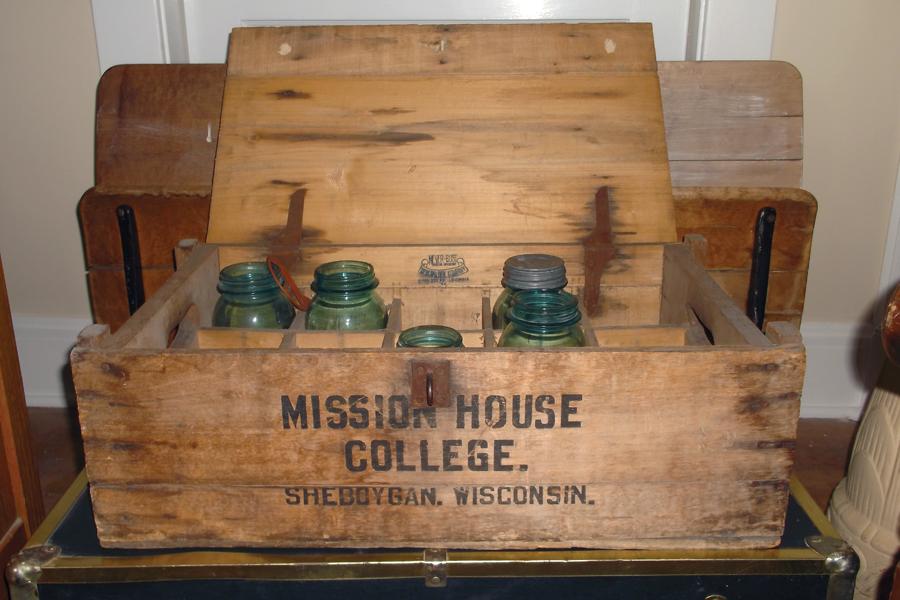There sits an old clock in the president’s house on Lakeland’s campus. Everything has a history, and the clock is no exception. From a visitor’s angle, the grandfather clock looked pristine, but hidden from sight was a charred wooden panel.
By the late 1960’s, Lakeland’s campus had started remodeling after the split with United Theological Seminary. Such changes included switching wooden furniture to steel and plastic. Most individual desks were replaced with tables. Some classrooms in Old Main, however, still house the old furniture.
Maintenance was asked to store the old furniture but no longer had a barn for storage due to a fire. The solution was to use the parking lot behind William A. Krueger Hall (WAK) (formerly Jubilee Hall) to build large bonfires and burn the old furniture. The charred remains were bulldozed and taken to the landfill.
According to Allen Wangemann, former professor of biology, maintenance even saved broken furniture through the year for homecoming bonfires.
Faculty at the time were also required to furnish their offices. Reverend David Lauer, new to the college in 1968, pulled out six chairs and a desk from a burn pile before the next bonfire.
“The only danger was losing historical pieces from the school,” Lauer said.
The rescuer of the clock remains anonymous, but the preservation of Lakeland’s history had begun.
“We probably would have lost everything without Catherine Krueger [wife of former president William Krueger],” Lauer said. “About the middle of the 70’s, she started grabbing everything she could find from the school [down to] the smallest coat hanger.”
“She believed that we needed to recognize our history and that we needed a museum,” Lucretia Crawford, associate professor of English, said. Many of these artifacts were taken out for display in the 2012 Sesquicentennial celebration.
Krueger filled the top floor of Nash Admission Building (formerly president’s house), then moved everything to the basement of WAK where a museum was created. Wangemann took over as curator in 1997 when Krueger retired.
When the college needed the basement space for faculty and staff in 2007, the contents of the museum were boxed up and stored in the basement of Brotz Hall (formerly North Hall).
Under former president Michael A. Grandillo, an archives committee was created in December 2012. Members include Crawford; Lisa Vihos, director of alumni relations; Rick Dodgson, assistant professor of history; Richard Wixon, associate professor of history and political science; Krista Feinberg, associate professor of history, and Pam Engebretson, assistant professor of general studies and director of academic advising.
“Grandillo called us all together and said ‘I am giving you the house on Prof Drive as long as you agree to move everything from Brotz by the end of January,’” Crawford said.
The timing coordinated with Lakeland’s decision to move IT to the basement of Brotz Hall.
Dating back to 1862, the house on Prof Drive is the oldest house on campus and was originally located where the WAK building is today.
Crawford’s Core 1B class helped move the boxes for their community service project.
“Right now the house is stuffed,” Crawford said.
Big furniture is housed on the first floor and the second floor has rooms of papers and books.
The attic is relatively empty except for a collection of old typewriters, which are a remnant of when Lakeland bought Sheboygan Business College in anticipation of new instructor Professor J. Garland Schilcutt in 1958.
Crawford and Vihos started sorting through the items over Spring Break.
“This is a huge endeavor,” Joe Beniger, manager of facilities and grounds, said.
“There are so many artifacts, pictures, and writings. It will take time to go through all of these, sort accordingly, and display in a reasonable manner.
“The real challenge when talking about archives is what you keep and what do you not keep, because you can’t save everything,” Dan Eck, interim president, said. “You have to focus your resources on the most important things.”
Help from an archivist is needed, and Vihos has begun looking for outside help. Vihos hopes that under the supervision of an archivist, the endeavor might be a great opportunity for a students as practitioners (SAP) project or student internships.
“For a college that has such a long history, it’s a no-brainer to have a place on campus where you showcase the history,” Vihos said. “This little house is perfect.”


